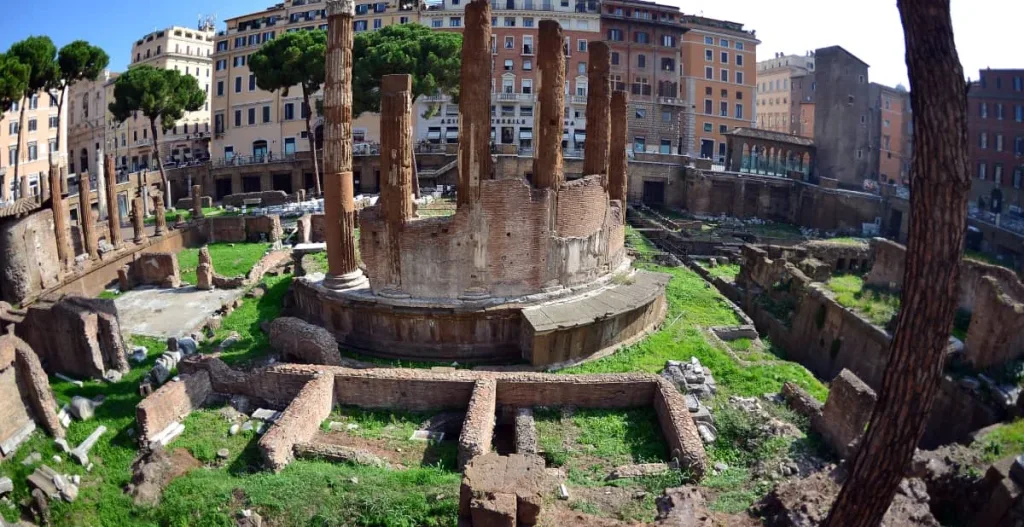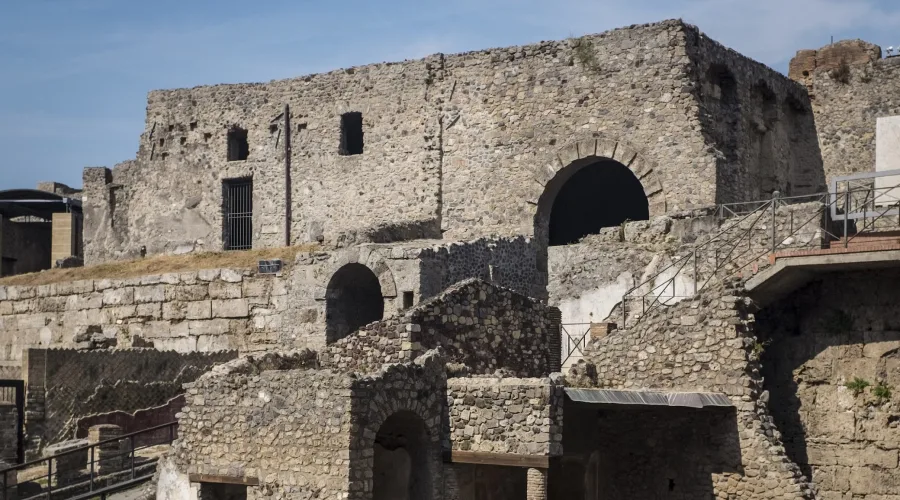Rome Restores the Scene of the Most Famous Political Crime in History

Rome, the eternal city, steeped in history and ancient mysteries, is embarking on a captivating journey to restore the very location that witnessed the most famous political crime in history – the assassination of Julius Caesar. This ambitious restoration project promises to transport visitors back in time, immersing them in the dramatic events that unfolded on that fateful day in 44 BC. Rome, the eternal city, is a place where every cobblestone has a story to tell. Among the countless narratives woven into the city’s rich tapestry, one event stands out as an enduring symbol of political intrigue and conspiracy—the assassination of Julius Caesar. Over 2,000 years have passed since that fateful day in 44 BC when the Roman Republic was forever altered, and now, the very spot where it happened is undergoing a remarkable restoration.
A Historical Overview of the Theater of Pompeii
The Theater of Pompeii, located in the city of Rome, is one of the most iconic historic structures that has stood the test of time and witnessed monumental events throughout history. Built in 55 B.C. by Pompey the Great, a prominent Roman military and political leader, the theater embodies the opulence and architectural grandeur of ancient Rome. With a capacity of over 20,000 spectators, this theater quickly became a cultural and social center of the time, hosting a variety of events ranging from classical theatrical performances to political and religious events. The date was March 15, 44 BC, a day etched into history as the Ides of March. Julius Caesar, the powerful Roman general and statesman, was lured into a fatal trap by a group of senators who feared his growing influence. Among the conspirators were Brutus, Cassius, and other prominent figures. On that day, inside the Theatre of Pompey, located in the Campo de’ Fiori area of ancient Rome, Caesar met his demise in a brutal assassination.
The design of the Pompeii Theater reflected the influence of Greek architecture, with a semi-circumference of tiered tiers rising above the orchestra, the semicircular area where performances were held. The structure incorporated key elements of Roman architecture, such as the use of arches and vaults, giving it a majestic appearance and impressive acoustics. In addition, its location in the city of Rome made it a vital epicenter of the cultural and social life of the ancient Roman civilization.
The theater not only hosted theatrical and musical performances and religious events, but also served as a venue for political speeches and civic gatherings. It witnessed memorable speeches by prominent Roman figures, as well as public demonstrations that influenced the political and social events of the time. The rich history of the Theater of Pompeii is interwoven with narratives of some of the most crucial events of ancient Rome, giving it an enduring historical importance in the cultural fabric of Roman society.
The Assassination of Julius Caesar and its Link to the Theater of Pompeii
The assassination of Julius Caesar, the Roman leader and general, occurred on March 15, 44 BC at the Theater of Pompey in Rome. This tragic event marked a turning point in the history of Rome and had important repercussions on the future of the Roman Empire. Julius Caesar was assassinated by a group of senators led by Brutus and Cassius, who opposed his growing power and feared that he would become an absolute monarch. The Theater of Pompey, where the assassination took place, was a large theater built by the Roman general and politician Pompey in 55 B.C. It was the first permanent theater in Rome and had a capacity to hold approximately 20,000 spectators. Although the theater was a place of entertainment for the Romans, it also served as a political stage and venue for public assemblies.
The use of Pompey’s Theater for the assassination of Julius Caesar was not a random event. The conspirators chose that particular location because Caesar was to attend a Senate meeting that day, and the theater provided a large, public space in which the attack could be carried out without arousing immediate suspicion. The assassination of Julius Caesar triggered a series of turbulent events in Rome, including the power struggle between Caesar’s supporters and the conspirators, which eventually led to the formation of the Second Triumvirate and, later, the Battle of Philippi. This event also marked the end of the Roman Republic and the beginning of the Roman Empire. The Theatre of Pompey was no ordinary theater; it was a grand complex that included a large open-air space for various public gatherings. It was within this complex that the Roman Senate convened on that fateful day. Caesar arrived at the Senate meeting in the morning, unaware of the conspiracy that awaited him. What followed was a calculated act of betrayal. As Caesar took his seat in the Senate, a group of conspirators surrounded him, delivering a series of fatal blows. His assassination marked a turning point in Roman history, leading to a series of civil wars and the eventual rise of the Roman Empire.

Renewing Lost Splendor: Restoration Challenges
Walking through the restored Theatre of Pompey, visitors will be transported to ancient Rome at the height of its power. They will experience the grandeur of the theater’s architecture, with its tiered seating, elaborate decorations, and stunning stage, where Julius Caesar met his fate. The immersive experience will provide a profound understanding of the political, social, and cultural dynamics of ancient Rome. Today, the Theatre of Pompey is an archaeological site that has largely been hidden beneath the modern city of Rome. However, a significant restoration project is underway to uncover and preserve this historically significant location. The project aims to recreate the theater’s appearance during Caesar’s time, allowing visitors to stand on the very ground where one of the most famous political crimes in history occurred.
The restoration includes not only the physical structure but also the surrounding area. The Campo de’ Fiori, once a bustling marketplace and the site of public executions during the Roman Republic, is being transformed to give visitors a sense of the historical context. Archaeologists, historians, and preservation experts are working diligently to ensure that the restoration is as accurate as possible, relying on historical records and ancient texts to guide their efforts.
Educational and Cultural Significance
The restoration of the Theatre of Pompey is not merely a physical reconstruction but also an opportunity to educate and enlighten. It will serve as a valuable resource for historians, archaeologists, and scholars studying this critical period in Roman history. Furthermore, the restored theater will be a cultural gem, attracting visitors from around the world who are eager to connect with the past. It will serve as a testament to the enduring fascination with Julius Caesar’s life and death, as well as the broader historical legacy of ancient Rome. As the project progresses, the Theatre of Pompey will offer a unique window into ancient Rome. Visitors will be able to walk in the footsteps of Julius Caesar and the senators who conspired against him. The restored theater will serve as a living history lesson, allowing people from around the world to connect with a pivotal moment in the Roman Republic’s downfall.

Preserving History for Future Generations
The restoration project is a testament to Rome’s commitment to preserving its rich historical heritage for future generations. It recognizes the importance of engaging with history in a tangible and meaningful way, allowing people to connect with the past on a profound level. As the Theatre of Pompey reopens its doors to the world, it becomes not only a remarkable historical site but also a symbol of the enduring significance of the past in shaping our understanding of the present and the future. It invites us to reflect on the consequences of political actions and decisions, even those made over two thousand years ago, and serves as a reminder of the enduring impact of history on our world today.
The restoration of the Theatre of Pompey is not just an effort to uncover ancient ruins but to preserve the legacy of Julius Caesar and the enduring impact of his assassination. The story of the Ides of March has reverberated through the ages, influencing literature, art, and political thought. By restoring the theater, Rome pays tribute to the historical significance of this event and offers a unique opportunity for visitors to engage with the past.
A Must-Visit for History Enthusiasts
For history enthusiasts, the restored Theatre of Pompey promises to be a must-visit destination. It is an opportunity to stand at the intersection of ancient history and contemporary life, bridging the gap between the Rome of the past and the bustling city of today. The restoration of this iconic site ensures that the story of the Ides of March will continue to captivate and educate generations to come. In Rome, history is not confined to the pages of a book; it lives and breathes in the city’s streets, buildings, and monuments. With the restoration of the Theatre of Pompey, another chapter in Rome’s remarkable history is being brought to life, reminding us that the echoes of the past continue to resonate in the present. As Rome restores the scene of the most famous political crime in history, it invites the world to bear witness to the enduring power of a story that has transcended time and become an integral part of our shared human heritage.
Conclusion
The restoration of the Theatre of Pompey in Rome marks a profound effort to reconnect with one of the most significant events in human history—the assassination of Julius Caesar on the Ides of March in 44 BC. It’s not merely an archaeological project but a poignant journey into the heart of ancient Rome and a window into the political intrigue, power struggles, and complex dynamics of the Roman Republic. This restoration takes history enthusiasts, tourists, and curious minds back in time to the very spot where Julius Caesar’s life met its tragic end. This endeavor represents Rome’s enduring commitment to preserving and sharing its rich history with the world. The Theater of Pompey, once hidden beneath modern streets and buildings, is now emerging as an essential historical site where visitors can connect with a pivotal moment in the Roman Republic’s transition to the Roman Empire. Through meticulous reconstruction and a deep understanding of historical context, the restoration brings the past to life, immersing us in the world of ancient Rome.
By preserving the legacy of Caesar and the legacy of that dramatic day in March, this project captures the imagination of history enthusiasts, scholars, and tourists alike. It invites us to stand on the same ground where history unfolded, where powerful individuals gathered to shape the destiny of Rome, and where an act of betrayal forever altered the course of civilization. As we walk through the reconstructed Theater of Pompey, we are reminded that the echoes of the past reverberate through time and continue to captivate our fascination. The Ides of March is not just a historical event but a symbol of political intrigue and power struggles that still resonate in today’s world. The restoration project is a testament to Rome’s commitment to storytelling and education, allowing visitors to engage with history in a deeply personal way.
Rome, with its enduring allure, offers an exceptional experience for anyone interested in history, culture, and the eternal city itself. The Theater of Pompey’s restoration stands as a testament to the enduring power of history and the universal need to connect with the past. It brings history from the pages of a book into the present, ensuring that the legacy of Julius Caesar and the political drama of ancient Rome will continue to inspire and educate generations to come.








